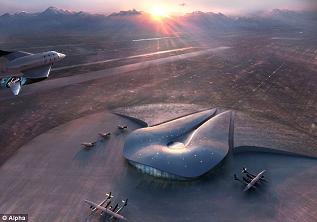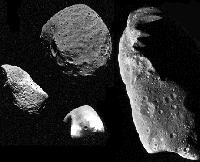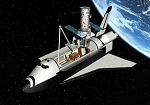The first thing you notice about the Mojave Air & Space Port is the large number of commercial airliners just sitting around under the desert sun. The climate here means it’s the perfect place for aircraft manufacturers to store planes whose owners haven’t managed to finish paying for them. If the spectre of this aviation elephants’ graveyard wasn’t strange enough, five miles to the west is the Tehachapi Pass Wind Farm – the second-biggest in the world, with more than 5,000 wind turbines.
 It’s a weird landscape; and it seems to inspire off-the-wall businesses, and the one-of-a-kind thinkers who run them. One of these businesses is called, with the kind of obviousness that seems redolent of a gentler age, the Spaceship Company – and in its workshop at the airfield, spaceships are being built.If that conjures up images of stick-drawing lunar modules or sleek, Wernher von Braun rockets tower-block high, think again: this spaceship is made of carbon fibre, powered by recycled nylon and laughing gas, and turns into a shuttlecock so it can flutter straight down to Earth. And instead of sitting on a launch pad in Florida it’s dropped from an aircraft built around the biggest piece of carbon fibre composite in history.And both are designed by a company whose founder lives in a half-buried pyramid in the middle of the desert decorated with murals of aliens communing with ancient Egyptians. This is the astonishing backdrop to what promises to be the first venture to take paying passengers into space.
It’s a weird landscape; and it seems to inspire off-the-wall businesses, and the one-of-a-kind thinkers who run them. One of these businesses is called, with the kind of obviousness that seems redolent of a gentler age, the Spaceship Company – and in its workshop at the airfield, spaceships are being built.If that conjures up images of stick-drawing lunar modules or sleek, Wernher von Braun rockets tower-block high, think again: this spaceship is made of carbon fibre, powered by recycled nylon and laughing gas, and turns into a shuttlecock so it can flutter straight down to Earth. And instead of sitting on a launch pad in Florida it’s dropped from an aircraft built around the biggest piece of carbon fibre composite in history.And both are designed by a company whose founder lives in a half-buried pyramid in the middle of the desert decorated with murals of aliens communing with ancient Egyptians. This is the astonishing backdrop to what promises to be the first venture to take paying passengers into space.
Sir Richard Branson’s Virgin Galactic isn’t the only company taking the business of space tourism seriously. But it’s further along with its preparations than its competitors, with its Sir Norman Foster-designed Spaceport America due to be completed next year in New Mexico, and its spaceship three months into its flight-test programme.Virgin Galactic is very close to realising the dream of making travel to the edge of space available to ordinary people – and those customers with £140,000 to spare are going to double the number of the world’s astronaut corps almost overnight. ‘New Mexico passed the legislation in March to allow for informed consent of participants,’ stresses Will Whitehorn, Virgin Galactic’s MD. As of now, under U.S. law these people are participating in this space programme. They’re astronauts – it’s a legal reality. There’s been just over 500 people in space since 1961 – we hope to carry 500 in our first year.’
To get numbers like this, Virgin Galactic needs a small fleet of spacecraft and the aircraft that carry them to 50,000ft for launch. The plan is for the Spaceship Company – a joint venture between Virgin Galactic and Mojave-based aerospace firm Scaled Composites – to build three launch aircraft and five spaceships, as Virgin Galactic works towards taking fare-paying ‘participants’ into sub-orbit space from 2012, and progress towards its goal of three daily spaceflights.
As the comprehensive flight-test programme gets under way, the first job of the test pilots is to ensure that the spaceship and mothership can fly safely, efficiently and as intended when joined together, and its these flights – known as ‘captive carry’ flights, because the smaller SpaceShipTwo craft will remain attached to the WhiteKnightTwo aeroplane – that are currently taking place from the Mojave Air & Space Port. Yet even as they fly the aircraft, the pilots are learning all the time about how to operate the spaceship as well. WhiteKnightTwo’s twin pods are the same size and shape as the tubular fuselage of SpaceShipTwo, their six-passenger interiors are identical, and the mothership and spaceship work on exactly the same control systems. So every time a test pilot flies the mothership, he’s getting experience controlling the spacecraft as well.
Unusually for a modern aircraft, computers do not control any of the onboard flight systems: there are computers, but they’re used solely for monitoring and informational purposes.Instead, both mothership and spacecraft are operated using traditional stick-and-rudder mechanical aircraft systems. The experience for the pilot is ‘like flying a Cessna into space,’ Whitehorn says. Even the mechanism that changes the angle of SpaceShipTwo’s wings – enabling it to adopt a fanned-out shuttlecock shape when plummeting back into Earth’s atmosphere – is manual, with a lever that operates a hydraulic system. This is an attempt to ensure that all the systems used will be as simple, and therefore as safe, as possible.
This thinking extends to the rocket propulsion system as well. The fuel used to send Apollo astronauts to the Moon was a highly combustible mixture of liquid nitrogen and kerosene-based aviation fuel; the astronauts were effectively sitting on top of a skyscraper-sized bomb. Clearly a system designed to carry passengers cannot be that volatile, so new technologies have informed the search for an engine that can boost SpaceShipTwo to its maximum speed of about 3,500mph.
The spacecraft will be fitted with a plug-in rocket booster, which can be removed after touchdown and a new fuel plug inserted to power the next flight. The fuel chosen isn’t some high-explosive compound: in fact, it sounds about as explosive as a wet salad. SpaceShipTwo will be powered by one of two solid fuels – rubber or recycled nylon.
‘The oxidiser (which combines with the fuel to produce thrust) is nitrous oxide – laughing gas,’ says Whitehorn. ‘And unlike other solid fuel engines this one can be switched off, by cutting the flow of nitrous oxide.’So it’s very reliable, and very, very safe.’ And it’s this rocket propulsion system that means the whole Virgin Galactic enterprise is shrouded in mystery. Cockpit or interior photos are unavailable because, as the system relies on rocket technology, the whole project is treated under U.S. law as if it was a weapon.
‘Every single picture that exists has to be vetted before it’s released,’ Whitehorn explains. ‘We won’t be allowed to release any detailed pictures of the interior until this thing goes commercial.’ Even for the experts at Scaled, the Virgin Galactic project has required them to go beyond what they’ve worked on before. Aside from the particular demands of a spaceship, the construction of WhiteKnightTwo has taken composite aircraft design up a level.
Essentially the airborne equivalent of a catamaran, the twin-hulled aircraft has to be immensely strong. To ensure there are no joints – creating potential weaknesses – Scaled had to create what Whitehorn says is ‘the largest single piece of composite ever built’, which runs along and inside the 140ft wingspan. This onepiece backbone means WhiteKnightTwo is, according to Whitehorn, ‘the strongest aircraft in human history.
‘There’s immense strength in the middle of the wing, which allows this vehicle to lift 17 tons to an altitude of 50,000ft. Then, when it drops the spaceship, WhiteKnightTwo becomes a zero-G flying machine – an astronaut training vehicle – and the people in the left hull, who are flying into space the next day, can do their final training in it. WhiteKnightTwo will turn on its side (with one wing pointing straight up and the other down to Earth), and fly in circles, so it becomes a flying centrifuge, generating seven times the force of gravity.’
if you want to find out where such revolutionary thinking comes from, you only have to drive for ten minutes from the Mojave airfield. On a dirt road beside a mailbox fashioned from the tail section of an old aircraft, there’s a half-buried house shaped like a six-sided pyramid sticking out of the desert sand. On one of its subterranean walls – so it’s said – there’s a mural showing aliens helping ancient Egyptians to build the monuments of Giza. And it’s in this house that the story of the Virgin Galactic enterprise really begins.
The home belongs to Burt Rutan, the pioneering aviation designer behind the Voyager aircraft, which flew around the world on a single tank of fuel in 1986. Rutan runs Scaled Composites, and he has produced some of the most ingenious designs in aviation. Although he’s told at least one interviewer he is convinced aliens helped build the pyramids, his single-minded way of looking at design problems has helped his company progress in areas the big aerospace corporations have had trouble getting their heads around – such as space tourism. In 2004, Rutan and Scaled, with funding from Microsoft’s Paul Allen, won the Ansari X Prize – a $10 million fund awarded to the first team that managed to put a man in low Earth orbit twice within a fortnight. Scaled’s design was called SpaceShipOne: a rocket launched at above-airliner altitude from a mothership.
Meanwhile, the other prime mover in the Virgin Galactic story was making his way to Mojave via Morocco. Richard Branson was an early convert to the idea of space tourism: Whitehorn, a long-time Virgin Group staff er, says discussions took place between the British mogul and the Soviet leader Mikhail Gorbachev in the Eighties that would have seen Branson journey into space on board a Russian Soyuz spacecraft. Then one night in 1996, in a bar in Marrakesh, ahead of the launch of one of his round-the-world balloon trips, Branson and balloon pilot Steve Fossett fell into conversation with Apollo 11 moonwalker Buzz Aldrin.’Richard asked why they never launched rockets into space from balloons – wouldn’t it be a lot cheaper?’ recalls Whitehorn, who was present.
‘Buzz then explained that the U.S. Navy had experimented with balloon-launched rocket capsules in the Fifties, but that it had been abandoned in the Sixties; and there was a programme called the X-15, which was a rocket launched from a B-52 bomber. End of story, until the next day, when Richard said to me, “We should keep an eye on these ideas.”‘ Three years later, Whitehorn was in Mojave, looking at a bizarre rocket/helicopter hybrid. ‘There was no way that was going to work,’ Whitehorn says. ‘But in the process, Richard went to Mojave to look at it, and while he was there he met Burt.’
Rutan’s first collaboration with Branson was the Virgin Atlantic Global Flyer – eff ectively a development of Rutan’s Voyager aircraft.’We’d just invested in the railway business, where you could go out and tell the companies what you wanted and they’d build a train for you on spec; but in the airline industry you had to take what you were given,’ says Whitehorn. ‘So Richard got very interested in composites, and then Steve Fossett suggested building a very fuel-e fficient high-altitude jet that could go around the world in three days.’








